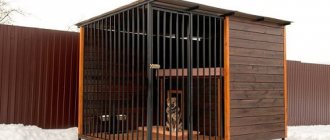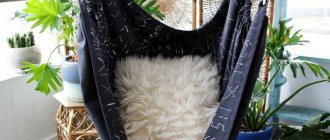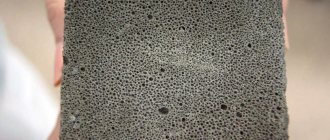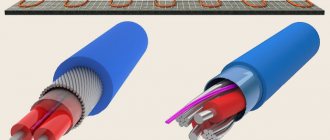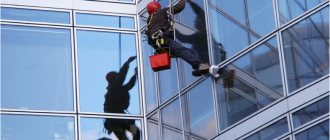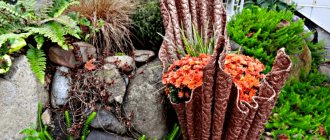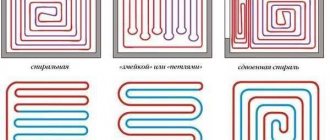On their plot, owners often make four-legged friends. Not every owner will allow animals to live in the house. Therefore, arranging a home for a pet is a manifestation of caring for it. A do-it-yourself dog house using improvised materials will be a good solution to the problem.
The kennel must meet the requirements: consist of environmentally friendly materials, be warm in winter and cool in summer
Useful tips
It is worth noting that the booth needs to be built for a long period, which means it is important to approach this issue thoroughly, and not use a barn or other utility room for these purposes.
Choosing a place
The most convenient place to create a dog kennel is near a gate, fence or other buildings that will need to be guarded, and the animal will have a good view of the entire area. You need to build on a hill or make a high foundation so that in winter during heavy snowfalls or in autumn when it rains, precipitation does not fall into the house and leave your pet’s bed damp.
You also need to provide the animal with partial shade so that the dog can hide in the summer heat, but you should not completely exclude the sun, because pets love to warm up their bones under the bright rays. If it is not possible to place the house near the shade of trees or buildings, then you need to build a long canopy that will create an artificial shadow.
To make the dog comfortable and not make mud piles every time after precipitation, it is better to build a good covering around the home, preferably made of wooden boards, since a cement or tiled floor can cause health problems for the animal.
In the photo, do-it-yourself dog kennels:
Materials
It is important to decide what is best to build a doghouse from. It is worth giving preference to wooden boards, but not painted or varnished. After assembling them, you can treat the surfaces with an environmental liquid against fungi and pests, and then dry them thoroughly so as not to cause allergies or other diseases in the animal.
It is better not to make metal or plastic structures, as they will be hot in the summer and too cold in the winter.
Stones, bricks, and cement may be suitable for building a kennel, but then you will need to insulate the inside with leatherette and polystyrene foam so that the dog does not catch a cold in the winter.
Dimensions
The doghouse should not be too large or very small, the dog does not need a lot of space to rest, but it is important to consider that a large room will quickly lose heat in winter and the pet will not be able to warm it with its body. The height should correspond to the height of the pet with its head raised, the width should be such that it can freely turn in any direction.
You can calculate the dimensions by measuring the animal:
- Height – measure the height from the ground to the tips of the ears with the pet’s head raised, add 5-7 cm to this.
- Length – the length of the animal from nose to tail in a standing position; it is necessary to add 4-15 cm to each measurement so that the pet has some free space.
- The width and height of the entrance should correspond to the width of the chest plus 4-6 cm, and the height from the floor to the animal’s nose.
Most often, owners use a table of optimal sizes:
| Adult sizes and breeds | Dimensions of the kennel and entrance hole for the animal, cm |
| Small breeds up to 50 cm at the withers, pugs, dachshunds, spaniels, fox terriers, beagles, mongrels | Ш – 70 G – 55 B – 60 Entrance w/h – 30/40 |
| Medium up to 75 cm, Shar Pei, Chow Chow, Husky, Shepherd, Dalmatian, Doberman, Bulldog, Labrador | Ш – 115 G – 75 B – 80 Input w/v – 35/45 |
| Large breeds up to 100 cm, Alabai, Asian Shepherd, St. Bernard. | Ш – 135 G – 100 B – 95 Input w/v – 40/60 |
Design features of the aviary
To eliminate possible discomfort for the dog when living in an enclosure, it is not only positioned correctly, but also certain dimensions are observed. There are the following options for constructing a comfortable enclosure:
- open type;
- closed;
- half-closed.
Open enclosures are structures in which the walls are visible. Usually metal rods are chosen for this. In this case, the dog can monitor what is happening from all sides. If the enclosure is built as a semi-closed type, one of the walls is usually made blank. Often, for this purpose, the structure is built close to another building on the site.
Since huskies are quite curious, it is better to build open or semi-open enclosures for them. You should not use mesh structures as walls. It is better to choose metal rods. This is due to the curiosity and activity of dogs. They can easily figure out the wicker structure. In addition, the result does not come without injury.
When building an enclosure, it is important to take into account the location of the cardinal directions. Those who live in the north should make the enclosure with the front side facing south. In this case, the pet will receive a lot of sunlight and warmth. In addition, the dog will not be bothered by cold winds.
Important! The enclosure must meet the requirements of convenience, safety and strength.
Several zones are created inside the structure - for relaxation, for walking, and a place where the booth will be located. The roof protects the dog from precipitation. The dimensions of the enclosure are made taking into account the growth of the pet. Usually dogs grow up to 60 cm at the withers. There are several options for booth sizes:
- If the dog is less than 50 cm tall, the enclosure is built with an area of 6 m2.
- When the height of the dog at the withers is 50-65 cm, it is better to make the structure with an area of 8 m2.
- If the pet's height is more than 65 cm, it is better to equip an enclosure of 10 m2.
When constructing a home for two dogs, the size of the building increases by 1.5 times. It is necessary to remember about bringing offspring. This will help you make a roomy and reliable enclosure in advance.
The foundation is made of concrete so that the structure is stable and durable. It is better to make the floors from wood - this way the dog will not freeze. Rods are chosen for the walls. Pillars - profiles or wooden beams - are installed under the roof.
How to make a dog house with your own hands
The simplest option for making a dog house is one made from boards and bars.
The photo shows drawings of kennels for different dogs:
Kennel for a large dog
The size of the house should correspond to the size of a large dog. How to build a simple booth for a big tailed friend:
- Take 2 bars 100 cm long and fasten boards 135 cm long to them using nails.
- Attach 2 bars 100 cm long and 2 125 cm long to the top of a kind of pallet, form a square into which the insulation is laid and covered with boards on top - this will be the floor.
- The side walls are fastened with self-tapping screws using 4 bars installed around the perimeter, their height should be 95 cm, and boards 100 cm long are placed on them from the inside.
- These boards need to be secured along the second edge with the same 4 bars, each 95 centimeters high.
- The back and front walls are formed in the same way, but they will need 125 cm boards. When forming the front wall, you need to leave space for a manhole 40 cm wide, 60 cm high, preferably closer to one of the walls, so that the animal can hide from the weather another wall.
- The side projections of the bars must be covered with foam plastic, and on top with any material that does not allow them to get wet and blown by the wind, for example, leatherette. The inside can also be upholstered with soft cloth or leatherette.
- Stuff boards on top of the bars for insulation, forming a kind of box.
- The roof can be made with a slope in one direction or with two according to the classical method - a triangle. More often, animal owners choose one with a slope in one direction.
- Boards are stuffed on top of the resulting box, forming a ceiling, a block 30 mm wide is nailed on one side, 50 mm wide on the other, one board needs to be filled on each side, forming a square. Fix foam or other warm material inside and cover it with boards so that the boards protrude along the edges, forming a canopy on all sides of the kennel. A plastic roof or other roofing material is attached to the top.
Video on how to make a dog house with your own hands:
For a small dog
For a small dog or puppy, you can use not only boards and bars, but also improvised means, for example, a frame from an old TV, additionally covering it with plywood or chipboard, but be sure to cover it on top with a waterproof material, such as roofing felt.
How to make a booth for a small dog with your own hands:
- It is, of course, better to start forming the flooring or floor from bars 2 pieces long. 70 cm and 2 pcs. 55 cm each. They can be fastened with screws or metal-plastic corners.
- Attach a rectangular sheet of chipboard measuring 70x55cm to the top.
- Attach 60 cm long bars at the corners; you will need 4 pieces. Cover them with a chipboard sheet measuring 67x55 cm. The sheets need to be cut from the top at an angle of 45°, so a margin of 7 cm is taken so that the roof can be screwed on at an angle.
- Also, a sheet measuring 90×75 is cut out of chipboard or plywood and secured so that the edges protrude 10 cm from the edge of the walls.
- It is better to cover the top of a kennel made of plywood or chipboard with a second layer of the same material or boards, and lay insulation in the form of roofing felt between them.
- After making the structure, it needs to be painted so that the materials are less damaged by weather changes.
- Before installing the kennel in a permanent place, you can make a podium, raising it 10-15 cm from the ground, with a width exceeding the width of the kennel, then it will be more convenient for the dog to rest in the summer and not carry dirt around the area.
Also, owners often make 2 holes in the podium, where they place 2 plates for food and water, so that the dog does not pull out and dirty, and also does not chew the dishes.
What can you build from?
The most common and comfortable material for animals is wood. In addition, the choice is very diverse. Exactly the same material can be used as for building a house for a person.
Dog house made of decking boards with a flat roof
The asymmetrical wooden structure with bright colors is pleasing to the eye
These can be logs, beams in the form of a log house or frame, covered with plywood or boards, or even parts from some old cabinet.
Kennel made of clapboard block house
Making a dog house from plywood
You can also use polymer wood, because WPC lasts much longer compared to natural wood.
However, given the harsh climatic conditions of some regions, many owners prefer to build a permanent house for their dog from brick, concrete blocks, and even stone.
Insulation can be placed under the siding sheathing
A creative approach to the design of a house, which is not only built in the form of a castle, but also plastered
These materials are cooler than wood, but the masonry will not be blown through. You can make the walls warmer by using hollow masonry material. For comfort, the walls are insulated from the outside and boards are laid on the floor.
Warm winter house made of OSB with siding
In summer, in such a kennel it will be easier for the dog to escape the heat, which is very important for the southern regions.
Read on our website: how to choose a booth and house for a dog.
Kennel for two dogs
The option for making a doghouse for two dogs should include 2 separate entrances and a partition between the single structure.
Its size depends on the breed of dogs kept. If they are small, then the length of a single booth should be at least 150 cm, from which the length of the partition must be selected.
If the animals are on a chain, then it is better to make an entrance on the opposite side from each other and a special partition so that the chain does not get confused when they play. Also, in this way the owner will delimit the space between the animals, which will allow them to feel more comfortable.
Aviary for huskies
The design includes a platform, a winter road and a booth. It is possible to equip an area where the dog will be walked. The winter road includes three blank walls made of wood and one lattice. There is a booth in the winter road. The dog should be comfortable in it. She will lie, sit and stand here. The platform is protected from precipitation by a roof.
In addition to the platform and winter road, there is a walking area in the enclosure. It is surrounded by a rigid mesh. The dimensions of the enclosure are calculated based on the size of the dog. For a husky, its length must be at least 8 m. The height of the enclosure is 2 m and the width is 2.5 m. An adult can jump over a wall up to three meters. Therefore, it is better to equip the roof with a solid type.
When building an enclosure, it is important to choose the right location. The front of the structure should face south. When facing north, a lot of snow will regularly fall into the winter road. Wind, from which the enclosure is not protected, can undermine the health of the pet.
The rectangle of the enclosure should be divided into three parts. At 1.5 m there will be a winter road, another 1.5 m will be occupied by a platform. The rest of the space is allocated for the platform. Boards are laid on the platform with the winter road. They are placed with a slight slope to make it easier to clean up after your pet. A gap is left between the bottom of the booth and the floor for air to pass through.
Warm booth for the winter
The design of a warm dog house can be anything; construction is possible from wooden blocks, boards, chipboard or bricks. The main thing, especially in regions with cold climates, is insulation of walls, floors and other tricks to retain heat.
It is important to select materials that the dog cannot damage; they should not be toxic. Another option for constructing a winter booth involves the presence of a vestibule, thanks to which the inside will always be closed from external conditions.
The first step is to make a double floor, in between which lay moisture-proof materials and insulation; this can be leatherette, roofing felt, polystyrene foam, penoplex, felt, mineral wool (but in no case glass wool), foam rubber, penofol or dry sand, hay.
The walls are also made according to this principle or insulated, covered with roofing material on top. But to make the booth a more comfortable temperature that will be maintained in winter, you can build a door from a piece of rubber or tarpaulin.
Before carrying out any insulation work, the external and internal parts of the dog kennel must be treated with liquid agents against insects that destroy building materials, mold and various types of fungi.
Place for an enclosure for a husky
One of the main conditions for creating comfortable conditions for the dog is choosing a place. A lot depends on this. The dog will not only sleep in the enclosure. This place is intended for eating, daily living, games and observing the territory.
Important! Individuals of this breed are very sociable. Attention to themselves is important to them. They cannot adapt to living alone. No matter the size of the enclosure, the pet always wants attention.
You need to constantly exercise your dog. They train and take her for walks every day. This allows the husky to feel that its owners need it. If these conditions are not met, the pet will get sick. Even the death of the dog is possible. This can be avoided by correctly placing the enclosure on the site. It is better to place it away from the street. However, a condition must be met - the dog should have a view of both the yard and the area beyond its borders.
A place is selected taking into account certain requirements - it must be well lit and dry. Ideally, there will be trees around the enclosure. However, they should not block the view of the territory. The shadows cast by the trees will protect the husky from the sun's rays during the summer heat.
It is prohibited to place a husky enclosure near structures that emit strong or unpleasant odors - latrines, pigsties, stables. It is important to exclude exposure of your pet to other irritating factors.
Attention! The place where it is decided to build an enclosure should be equipped with running water and electricity.
Pet shelter
To create a canopy you will need several metal, metal-plastic pipes or wooden blocks. Plastic sheets, corrugated sheets or slate may be suitable for a canopy. It is better to cut out pieces of the canopy, such that they will cover the roof of the booth.
At a distance from the side or front wall of the kennel, dig 2 pipes or long, thick bars that will serve as a support for the canopy on one side, and on the other side the support is the roof of the kennel.
For a stand on the ground, you can place a wooden pallet under the roof, which is leveled with a sheet of plywood. If the roof is triangular, then the canopy is attached at a large angle from the junction of 2 roof sheets or is fixed under its overhang. This is necessary to prevent water from pouring between the joints.
conclusions
By creating a doghouse for a husky or a husky, the owner not only takes care of the dog, but also creates a home for the pet in accordance with the design of the adjacent buildings. This solution is optimal.
Recommended Posts
DIY frame sauna
How to choose a stove for a Russian wood-burning sauna
How to build a cellar under a barn with your own hands
Rolling gates for the home
How to build a garage with your own hands cheaply and quickly
How to clean a country toilet
Necessary materials
It was already mentioned above that only environmentally friendly and high-quality materials are selected for dog housing. The best option is considered to be wood, namely conifers. For construction, it is customary to use lining, the thickness of which is 12.5 mm. This material is used for external cladding. Other materials you will need are plywood, fiberboard, chipboard, and floorboards. It is worth preparing special bars in advance, the sizes of which are 100x100 mm, 40x40 mm, 100x50 mm. The blocks will be used to make the outer corners. A wooden corner is perfect for decoration. Decorative slats and a special symmetrical plinth would be a good option.
Issues of comfort and safety
How and with what to disinfect against parasites
In addition to being treated with antiseptic agents during manufacturing, it is also looked after after the dog has settled there. Cleaning consists of collecting scraps, bones, wool and other unnecessary items in dog homes. Disinfection is carried out with special solutions every month in the summer, and once a quarter at other times of the year. For disinfection, formaldehyde, Lysol or creolin (3%) is used. Care must be taken to ensure that the dog does not enter the kennel until the solutions dry.
How to treat against ticks
A drug called Butox is used for ticks and fleas. One ampoule is diluted into four liters of water, and this solution is sprayed throughout the dog’s home. After such disinfection, the dog should not enter the booth for 10 hours. The treatment lasts up to 10 days, but repeating it more often is not recommended if you do not live in a forest where such insects are common.
Nail polish is an ideal tool for pulling ticks out of your dog's skin. The varnish prevents the tick from breathing, and it falls off on its own.
How to insulate and heat. What to put on the floor
To insulate the floor and walls of the booth, the wooden parts are first treated with antiseptic impregnation. The bottom is covered with roofing felt, waterproofing the booth. The inner part of the bottom is lined with glassine, on top of which we put insulation: glass wool, mineral wool and polystyrene foam, and then glassine again on top. We lay a floor of planks on top of this insulation. Walls are insulated in the same way. For coziness and comfort, cover the floor in the booth with a rug.
Optimal and standard dog house sizes for medium and large breeds
Let's find out what parameters a medium-sized dog will feel most comfortable in in a kennel.
So, a dog whose length does not exceed 120 cm and width - 75 cm is considered average. The height of such an animal is no higher than 80 cm. You can focus on the standard German Shepherd: larger dogs will be larger than this animal.
Of course, when building a booth, you need to look not only at standard sizes, but first of all at individual ones. So, make sure that when entering the booth the dog’s chest passes freely through the hole: otherwise he will not want to live in such a “house”. To make the entrance hole the right size, measure the dog’s chest and add 5-8 cm to the resulting figure: this is the width the hole should be. Its height should be 5 cm less than the height of the dog at the withers: this way it will be most convenient for the animal to walk “home”.
The inside of the booth should be more spacious. The dog should be able to freely stand in the kennel at full height: the height of the building should be 5-8 cm greater than the height of the animal.
Video: calculating the size of a booth for an adult dog
The video shows the dimensions of a booth for a medium-sized dog:
Of course, the parameters can be changed, but preferably upward, so that the dog is guaranteed not to find himself in cramped conditions. Before you begin construction, take your dog's measurements several times to make sure they are accurate.
What can and cannot be insulated?
When choosing insulation, do not forget that the dog relies on its instincts. It’s impossible to tell her that you shouldn’t chew the rug, or that you shouldn’t tear off the canopy that covers the hole.
Let's consider several options for insulating a dog house for the winter, their pros and cons:
- the first thing to remember is that the insulation must be closed on both sides, otherwise the dog will simply tear it apart;
- if mineral wool is used for insulation, then perlite should be laid between the wall and the heat insulator. It will not only preserve the properties of cotton wool, which can absorb moisture and lose its properties, but will also protect the dog’s respiratory tract from irritation;
- The canopy should be chosen from a dense and durable material, otherwise your pet will quickly tear it apart;
- If possible, the thermal insulation material should be natural.
Electric heating
It is possible to perform forced insulation if wiring is carried out to the booth. A warm heated kennel (such as a mat) has the following advantages:
- the temperature in the kennel is constant, even in extreme cold;
- Electric heating dries the air in the structure, which is important.
But there are also disadvantages that cannot be ignored:
- The dog is an active and curious animal, and can get to the electric heating elements. There is a danger of electric shock.
- If there is constant dampness, a short circuit may occur.
- You can try and protect your dog from these troubles, but then the cost of the kennel will increase significantly.
Felt
The simplest and most inexpensive insulation that can be installed in a matter of hours:
- Using a stationery or construction knife, cut out the elements of the required size;
- Secure the material to the inside of the kennel using a stapler and staples.
The result is high-quality insulation with natural material that is not afraid of wind and frost. An important point is that this heat insulator has high vapor permeability.
Mineral wool
It is better not to use this heat insulator, since for high-quality insulation you will have to build a structure with thick walls, and you will have to install a vapor barrier. It is also worth noting that mineral wool has the ability to settle and get wet at high humidity, and this reduces its insulating ability by almost half.
Styrofoam
This thermal insulation material has many advantages:
- provides high-quality insulation of the structure from outside cold;
- the material does not absorb moisture, does not shrink over time, and its properties will not be lost over time;
- It’s not difficult to insulate the booth; just cut out the heat insulator boards and install them. In this case, there is no need to use a vapor barrier.
Available means
But you can also insulate the structure with available materials, such as old sweatshirts or a blanket. The insulation will be no worse than with the above methods. The only downside is that this insulation is short-lived, and the quilted jackets can harbor rodents.
Or just invite the cat
